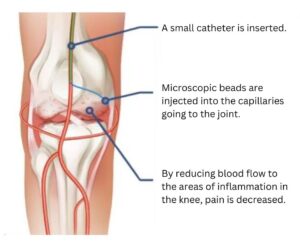Osteoarthritis of the Knee
Genicular Artery Embolization (GAE) is a cutting-edge, minimally invasive procedure designed to alleviate knee pain caused by conditions such as osteoarthritis. This innovative treatment targets the geniculate arteries, which supply blood to the lining of the knee. By selectively blocking these arteries, GAE reduces the inflammation and pain associated with knee degeneration.
Treatment
The GAE procedure is performed by one of our specialized interventional radiologists in our outpatient imaging center. Here’s a step-by-step overview of what to expect:
- Preparation: The first step is having a clinic consultation. You’ll receive detailed instructions on how to prepare for the procedure, including any adjustments to your medications.
- Sedation: While GAE is less invasive than surgery, you will receive local sedation to ensure comfort, and sometimes, sedation may be used.

- The Procedure: The radiologist makes a small puncture at the artery at the top of the thigh, to access your vascular system. Using advanced imaging techniques, a catheter (a thin, flexible tube) is navigated to the geniculate arteries. Microscopic beads are then injected into the capillaries going to the joint, reducing the blood flow that contributes to inflammation and pain.
- Completion: The entire procedure typically lasts between one to two hours. After the embolic material is successfully deployed, the catheter is removed, and the incision is closed, often requiring only a bandage.
Recovery After Genicular Artery Embolization
Recovery from GAE is relatively quick compared to traditional knee surgery:
- Immediately After: Patients are monitored on bedrest for 2-3 hours to ensure there are no immediate complications.
- Going Home: Patients can go home the same day, although you will need someone to drive you.
- Post-Procedure Care: You’ll receive instructions on how to care for the puncture site, manage pain, and any signs to watch for complications.
- Activity Level: It’s common to experience some soreness and swelling in the knee, but many patients can resume normal, non-strenuous activities within a few days. A gradual return to more vigorous activities will be guided by our doctor’s advice.
- Follow-Up: Follow-up appointments are crucial to monitor your healing and progress.
Benefits of Genicular Artery Embolization
Patients who undergo GAE can expect several benefits:
- Pain Relief: Most patients experience significant pain reduction within weeks following the procedure, improving quality of life.
- Minimally Invasive: With no large incisions, the risk of complications and the recovery time are significantly less than with conventional surgery.
- Quick Recovery: The minimally invasive nature of GAE allows for a faster return to daily activities.
- Reduced Need for Pain Medication: As the knee pain is alleviated, there’s often a decreased reliance on pain medications, including opioids.
Insurance Coverage
Our team will work with insurance companies to verify coverage for your consultation as well as any procedures you may require.
Is GAE Right for You?
Genicular Artery Embolization offers a promising alternative for those suffering from knee pain due to osteoarthritis or other conditions when conservative treatments have not been effective. However, it’s not suitable for everyone. Discussing with your healthcare provider is crucial to determine if GAE is an appropriate option based on your medical history, current health, and specific condition.
The Next Step
Patients who are interested in Genicular Artery Embolization should contact their healthcare provider who will work with our TRA Endovascular team on a plan to evaluate and treat your condition.
